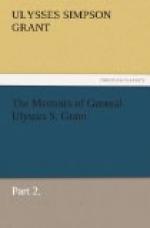I, as regimental quartermaster, had charge of the public property and had also to look after the transportation. A contract had been entered into with the steamship company in New York for the transportation of the regiment to California, including the Isthmus transit. A certain amount of baggage was allowed per man, and saddle animals were to be furnished to commissioned officers and to all disabled persons. The regiment, with the exception of one company left as guards to the public property—camp and garrison equipage principally—and the soldiers with families, took boats, propelled as above described, for Gorgona. From this place they marched to Panama, and were soon comfortably on the steamer anchored in the bay, some three or four miles from the town. I, with one company of troops and all the soldiers with families, all the tents, mess chests and camp kettles, was sent to Cruces, a town a few miles higher up the Chagres River than Gorgona. There I found an impecunious American who had taken the contract to furnish transportation for the regiment at a stipulated price per hundred pounds for the freight and so much for each saddle animal. But when we reached Cruces there was not a mule, either for pack or saddle, in the place. The contractor promised that the animals should be on hand in the morning. In the morning he said that they were on the way from some imaginary place, and would arrive in the course of the day. This went on until I saw that he could not procure the animals at all at the price he had promised to furnish them for. The unusual number of passengers that had come over on the steamer, and the large amount of freight to pack, had created an unprecedented demand for mules. Some of the passengers paid as high as forty dollars for the use of a mule to ride twenty-five miles, when the mule would not have sold for ten dollars in that market at other times. Meanwhile the cholera had broken out, and men were dying every hour. To diminish the food for the disease, I permitted the company detailed with me to proceed to Panama. The captain and the doctors accompanied the men, and I was left alone with the sick and the soldiers who had families. The regiment at Panama was also affected with the disease; but there were better accommodations for the well on the steamer, and a hospital, for those taken with the disease, on an old hulk anchored a mile off. There were also hospital tents on shore on the island of Flamingo, which stands in the bay.
I was about a week at Cruces before transportation began to come in. About one-third of the people with me died, either at Cruces or on the way to Panama. There was no agent of the transportation company at Cruces to consult, or to take the responsibility of procuring transportation at a price which would secure it. I therefore myself dismissed the contractor and made a new contract with a native, at more than double the original price. Thus we finally reached Panama. The steamer, however, could not proceed until the cholera abated, and the regiment was detained still longer. Altogether, on the Isthmus and on the Pacific side, we were delayed six weeks. About one-seventh of those who left New York harbor with the 4th infantry on the 5th of July, now lie buried on the Isthmus of Panama or on Flamingo island in Panama Bay.




